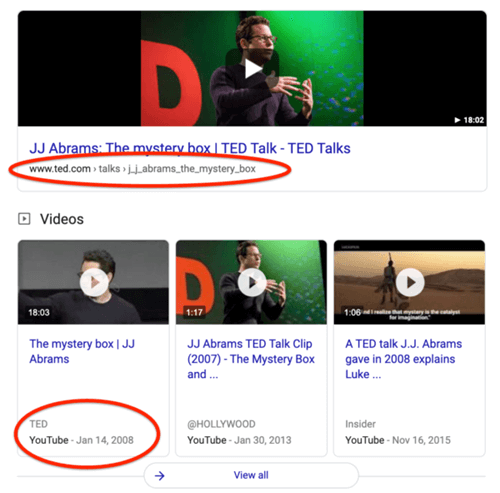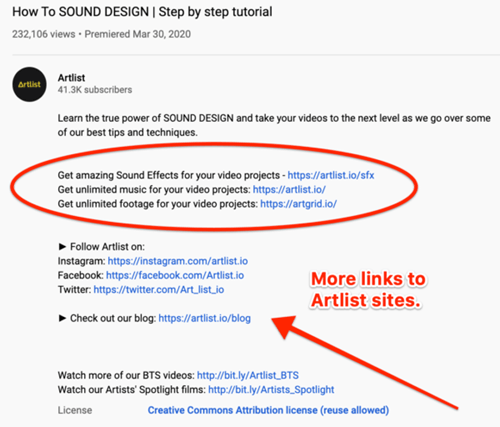Highlights
Table of Contents
Explore article topics
I’ve recently written a post about 4 tactics creators need to take in their marketing strategy, and one of these tactics was to use SEO. Here I’ll explain how to do it effectively.
For years my standard protocol for maximizing video SEO (search engine optimization) had been, put your video everywhere (i.e., YouTube, Vimeo, etc.) then embed the most appropriate player (usually Vimeo or YouTube) on your site.
However, lately, my eyes have been opened, and I’ve come to the realization that just blindly putting your (or your clients’) videos everywhere, then embedding Vimeo (or YouTube) may not be the best way to maximize SEO. In fact, you are most likely hurting it.
So, to that end, here are three myths to debunk about video SEO.
Myth #1: Good video SEO means getting as many views as possible
Most of us content creators want our videos seen as many times as possible. The higher the stats on our YouTube or Vimeo channels, the better. And I see a lot of video creators writing blog posts and telling clients that video SEO is about “making a video and putting it on YouTube.” But that ISN’T SEO.

Remember, SEO is about optimizing the number of people who find you and your business. Depending on the video, many views may be a good ego boost and could help with brand recognition. Still, it doesn’t necessarily translate into good SEO for your website. Are those views leading people to your site? Are they converting into business? This is not to minimize the positive effect of lots of views. Just don’t confuse it with SEO.
Myth #2: Putting your videos on YouTube increases your search rankings
Just because Google owns YouTube, YouTube videos in and of themselves do not make your videos have better search engine results. Neither does embedding a YouTube video increase the chances of your page getting ranked higher. The rankings of your page on Google are based on a whole host of factors (e.g., relevance of content, keywords, link backs from other sites, etc.) Whereas having a relevant video can help boost search engine results overall since rich content like video is a plus for search engine optimization, all things being equal, a YouTube video won’t rank your page any higher than any other video.
In fact, unless you are a YouTuber and you plan to make a living (or your primary source of revenue) from YouTube ads, putting your or clients’ videos on YouTube could be hurting you. Why? Because if your YouTube video ranks high in a Google search, you will be sending traffic to YouTube. This is great if you are a YouTuber, not necessarily great if you try to get people to visit your main website.
Myth #3: YouTube is good SEO because it’s the second-highest search Engine
You often hear people proclaim that because YouTube is the second largest search engine (second only to Google itself), that is reason alone to put all your videos on YouTube. The problem with that thinking is that when people seek out a product or service, they usually don’t start on YouTube. They start on Google. That means, if your promo video that is uploaded on YouTube does come up in a search engine result, the link to that video will go to YouTube. Once there, your video will be competing with loads of distractions from other related content (not to mention ads). A good video SEO strategy aims to get the search engine result to link to your page, not YouTube.
What is good video SEO?
As I’ve come to learn, the primary objective of an effective video SEO strategy is to maximize the traffic to your website via the effective production and distribution of video. You accomplish this in three ways:
- Host your video on a self-hosted, professional platform
- Create a video sitemap that tells Google your site is the official home of your video
- Know when and what kind of videos to use on YouTube and Vimeo to capture the audience that is there
When video SEO is working properly and effectively, your web pages with video come up in Search Engine Results Pages (SERPs) it’ll have what’s called a rich snippet. Those video thumbnails you see when a search engine result links to a page with a video. Links on SERPs with rich snippets typically get clicked before regular text links because your eye is drawn to the images. When you’re doing video SEO right, that link will lead to your website.
Below are the search engine results for the JJ Abrams TED video. The video is located on both TED (via TED’s video player) and, of course, on YouTube. When you do a Google search for the video, they both come up. As you’ll see, one result links to the TED site, and one to YouTube.

Your goal is to get this kind of result, but with the higher ranking link being to your site. As you see here, the TED version of the video page ranks higher than the YouTube version. The key to this involves 1) self-hosting your video and 2) creating a video sitemap.
Self-hosting
Chances are most of you reading this use either YouTube or Vimeo to host your videos. Those are great services, and they have their place. If you are a YouTuber, it absolutely makes sense to drive traffic to your YouTube channel. But if you are using video to help maximize your SEO and drive traffic to your main site, you need to be smart about using social sharing sites like YouTube.
When you host a video yourself or use a professional hosting site like Wistia, Brightcove, or Vimeo Pro, the video is hidden from search engines and the web (full disclosure: Wistia is a client of mine.) Unless you have a link directly to that video, it won’t appear. Why? Because they are designed so that the web page where you host that video is the “owner” of the video. The link to that page will be the link that Google will serve up in the SERP.
Get unlimited high-quality music for your videos
How to best utilize YouTube in your video SEO strategy
Let me be clear about something: I am not saying you shouldn’t use YouTube. Far from it. In fact, YouTube absolutely should be part of your overall video strategy. As I mentioned earlier, if you are a YouTuber looking to grow your channel and earn revenue from it, the more people you drive to your channel, the better.
However, if you have another main website you run or create videos for a client, you’ll want to use the strategy I described. But you’ll want to do it in conjunction with a smart YouTube strategy. I recommend embedding a self-hosted video on your main site first for a week or so to get it registered by Google as the “main” home for your video. Then upload the video to YouTube, using good tags, titles, and descriptions to drive traffic already on YouTube to your channel. Read more on in our SEO for Youtube article.
People who are already on YouTube are searching for either education or entertainment. There are hundreds of millions of users on the platform. As much as possible, you want to drive that traffic to your channel, then from that channel to your websites.
Below is Artlist’s tutorial on how to sound design. As of this writing, it has almost a ¼ of a million views.
Look at the description for this video:

There are all kinds of links leading you back to websites owned by Artlist. The best thing to do is create a template for your description, with all of this info pre-populated. Then add new text and adjust as needed.
What’s next?
I’ve established what the myths are to video SEO and given you some tips on using it more effectively. In my next installment, I want to address another key part of having a strong video SEO strategy: creating a video sitemap.
For nearly 20 years, Ron has been a professional video producer, content marketer, and influencer in the visual arts industry. Most recently was managing editor of the Frame.io blog and currently managing editor of Film Riot. He helps brands and creative artists tell their stories using video, content, and words. You can learn more about him at https://bladeronner.media.
Share this article
Did you find this article useful?
Related Posts
- By Tim McGlinchey
- 12 MIN READ
- By Jonathan Mateer
- 6 MIN READ
Latest Posts
- 17 Apr
- By Daniela Bowker
- 7 MIN READ
